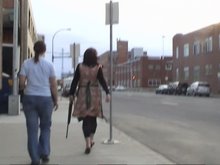Tonight’s informal artists’ discussion featured Lori Weidenhammer, Amber Landgraff and Emma Waultraud Howes. All three artists briefly summarized their works that have been actualized over the last three days and raised diverse issues that carried through in the informal discussion.
The problem of a performing for an invited festival audiences was raised through Emma’s series of performances for the project,‘Subtle Architecture’. Many gallery audiences seeking to witness the performances are unable to locate her movements. There is a noticable tension in the desire by audiences to witness the events, and the artist’ desire to challenge such a witnessing. An important question was raised. How can the festival accommodate this “zone of indescernibility” when art’s venues like latitude 53 are obliged to host art “for the public audience”? This question is certainly not a new one, but it continues to impact the presentation and therefore the potential content of works- by its insistence on audience participation. There is an implicit assumption by funding structures that artists need an audience to witness the event, in order to authenticate it as performance or art. This follows the notion of artists as cultural workers who’s role is to speak to “the public”. While this is most certainly a desire and motivation for the production of some site-specific performance works for by artists in the festival, most are questioning the assumptions of how one witnesses a performance and how publics are amorphous and multifaceted.
The notion of exchange with audiences soon followed. If works are not to be exchanged with invited audiences from the festivals, then how does exchange function in such a context?
Questions around problems of documenting are also raised. Key points of concern include:
In what ways does documentation impact the reception of site-specific work?
How might documentation function in duration through time?
How does documentation affect modes of access, encounter and reception with the audience?
How is history and mythmaking of performance events created via documentation?
How the excess of documentation functions in artistic practice?
How is the fragility and shortened life span of electronic media documentation vs analog media impacting performance art practices today?
Interestingly, surveillance as a form of documentation and evidence was not brought up.
(This is an issue particularly relevant to the theme of the city and is present in many works, especially Emma's recent performances.)
Subscribe to:
Post Comments (Atom)



No comments:
Post a Comment